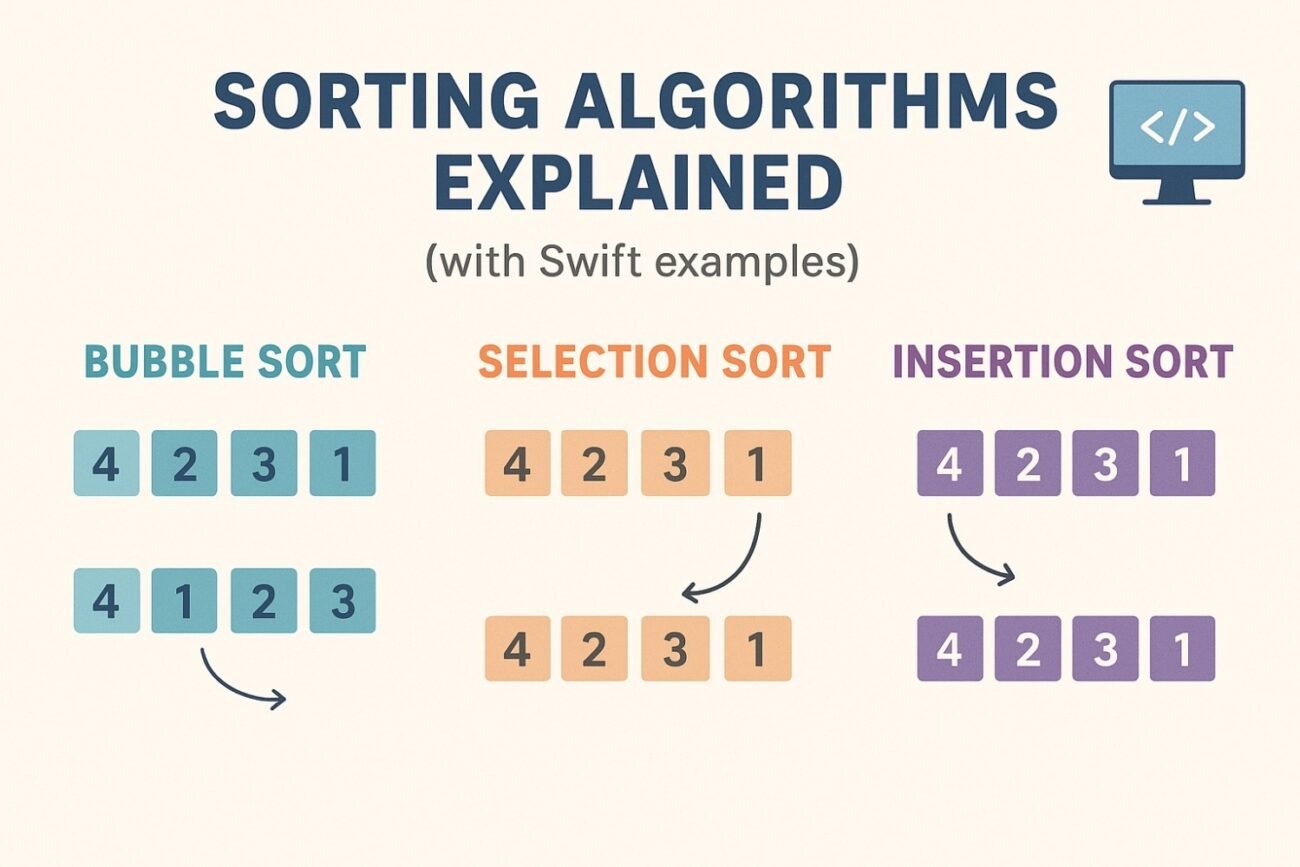Sorting is one of the most common programming problems, often asked in interviews. In this post, we’ll cover three beginner-friendly algorithms:
- Bubble Sort – largest element “bubbles” to the end each pass
- Selection Sort – repeatedly selects the smallest element
- Insertion Sort – inserts each element into the correct place
We’ll explain each with Swift code examples and step-by-step illustrations.
🔹 Bubble Sort
Bubble Sort repeatedly compares adjacent elements and swaps them if they are in the wrong order. After each pass, the largest element moves to the end, just like bubbles rising to the top.
Example (unsorted array: [5, 3, 8, 4, 2])
Pass 1:
[5, 3, 8, 4, 2] → swap → [3, 5, 8, 4, 2]
[5, 8, 4 , 2] → swap → [3, 5, 4, 8, 2]
[8, 2] → swap → [3, 5, 4, 2, 8]
Pass 2:
[3, 5, 4] → swap → [3, 4, 5, 2, 8]
[5, 2] → swap → [3, 4, 2, 5, 8]
…and so on until sorted.
func bubbleSort(_ array: inout [Int]) {
for i in 0..<array.count {
for j in 0..<array.count - i - 1 {
if array[j] > array[j+1] {
array.swapAt(j, j+1)
}
}
}
}
var numbers = [5, 3, 8, 4, 2]
bubbleSort(&numbers)
print(numbers) // [2, 3, 4, 5, 8]🔹 Selection Sort
Selection Sort finds the smallest element and moves it to the front. It keeps repeating this process for each position in the array.
Example (unsorted array: [5, 3, 8, 4, 2])
Pass 1: Smallest is 2 → swap with first → [2, 3, 8, 4, 5]
Pass 2: Smallest from index 1 is 3 → already in place
Pass 3: Smallest from index 2 is 4 → swap → [2, 3, 4, 8, 5]
Pass 4: Smallest from index 3 is 5 → swap → [2, 3, 4, 5, 8]
func selectionSort(_ array: inout [Int]) {
for i in 0..<array.count {
var minIndex = i
for j in i+1..<array.count {
if array[j] < array[minIndex] {
minIndex = j
}
}
array.swapAt(i, minIndex)
}
}
var numbers = [5, 3, 8, 4, 2]
selectionSort(&numbers)
print(numbers) // [2, 3, 4, 5, 8]🔹 Insertion Sort
Insertion Sort works like sorting playing cards in your hand. Each new card (element) is compared and inserted in its proper place.
Example (unsorted array: [5, 3, 8, 4, 2])
Start with [5]
Insert 3 → [3, 5]
Insert 8 → [3, 5, 8]
Insert 4 → [3, 4, 5, 8]
Insert 2 → [2, 3, 4, 5, 8]
func insertionSort(_ array: inout [Int]) {
for i in 1..<array.count {
var j = i
let key = array[i]
while j > 0 && array[j-1] > key {
array[j] = array[j-1]
j -= 1
}
array[j] = key
}
}
var numbers = [5, 3, 8, 4, 2]
insertionSort(&numbers)
print(numbers) // [2, 3, 4, 5, 8]Final Thoughts
- Bubble Sort is best for learning, but rarely used in production.
- Selection Sort is simple but inefficient.
- Insertion Sort is practical for small datasets.
- For larger datasets, you’ll want to learn Merge Sort and Quick Sort (coming soon).

